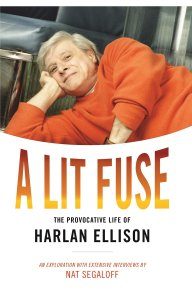Paul Di Filippo Reviews The Girls with Kaleidoscope Eyes by Howard V. Hendrix
 The Girls With Kaleidoscope Eyes: Analog Stories for a Digital Age, Howard V. Hendrix (Fairwood Press 978-1-933846-77-4, $17.99, 318pp, trade paperback) August 2019
The Girls With Kaleidoscope Eyes: Analog Stories for a Digital Age, Howard V. Hendrix (Fairwood Press 978-1-933846-77-4, $17.99, 318pp, trade paperback) August 2019
I do believe I’ve read all six of Howard Hendrix’s ingenious, well-crafted and entertaining novels, all of which I’ve enjoyed immensely. When, retrospectively, his output of novels seemed to cease with Spears of God, in 2006, I was dismayed and sad. For one reason or another, voluntarily or involuntarily, he seemed to be taking a step back from fiction. But the appearance of this new collection gives me hope that we will see lots more work from him in the future.
But for the present, we Hendrixophiles will content ourselves with these tales, which exhibit Hendrix’s far-seeing vision, cleverness and range of effects.
“Knot Your Grandfather’s Knot” (Analog, 2008) is a time-travel piece at once old-fashioned and cutting-edge. Mike Sackler, our hero, is a kind of Heinleinian Competent Man, and yet he’s reached a dead end in his life that has him on the brink of suicide by alcoholism. But a message from the past, along with an odd bequest, eventually saves him, and allows him also to save someone else very close to him. Hendrix posits a fresh kind of time travel that involves “the chaos of brain, the individuality of mind, the singularity of memory.” And the venue in the past—the 1939 World’s Fair—is keenly rendered.
A somewhat Simakian aura imbues “Habilis” (Carbide Tipped Pens, 2014) with a futuristic nostalgic glow (if that’s not an oxymoron), as our narrator listens to the wartime anecdotes of a friend who fought the alien Bots, which culminate in a possible posthuman leap. This tale illustrates how Hendrix likes to deftly blend intellectual theories and conceits into his dialogue.
A full novella, the title story (Analog, 2017) reads like an episode of the X-Files scripted by Greg Egan and John Wyndham. Our protagonist is FBI Special Agent Ciera Onilongo, a figure delineated by Hendrix with myriad apt instances of personality and action. Sent to examine a thwarted mass murder—a certain Professor Marston attempted to blow up his classroom of sixteen young female students before seemingly having a last-minute change of heart—Ciera discovers a huge web of weirdness that ultimately has her questioning reality and the future of the species. Hendrix brings in everything from artificial intelligence to parthenogenesis in a full-blown Pynchonian conspiracy plot. The story’s ending is particularly dramatic and hard-hitting.
There’s a surface zest and zip, a cheery optimism, to the post-scarcity, posthuman future in “Monuments of Unageing Intellect” (Analog, 2017) that reminds me of Moorcock’s Dancers at the End of Time series. But just like that predecessor, Hendrix’s tale about one of the rare non-immortal inhabitants of this era conceals, then reveals, an underlying melancholy and despair, as our protagonist, Hisao, begins to realize what the species has lost amidst its victories.
“Palimpsest” (Analog, 2007) presents us with the problem of “godspam,” communications of unknown origin that are popping up in the blended virtual-real world network. Attempts to filter the unintelligible messages, however, lead to a very apocalyptic outcome.
Author Art Holcomb gets collaborative credit on the wild-eyed, gonzo tale “The Perfect Bracket” (Analog, 2016). A seemingly naive lucky fellow wins a billion dollars from Vegas bookies for predicting the entire path of the NCAA tournament correctly. But when’s he’s confronted by our suspicious hero, things go pear-shaped very quickly.
“A Little Spooky Action” (Analog, 2017) is a bit of flash fiction that finds a Vegas magician wowing an audience of scientists with his intuitive knowledge of quantum mechanics.
Hendrix demonstrates that he is master of the hook-laden opener full of alluring mysteries in “The Infinite Manqué” (Analog, 2016).
I don’t expect what I’m writing here to bring back Panto or Fabian. I don’t expect it to cure the P group bonobos of the brutal dementia they are enduring. I don’t expect it to bring the VLADs, or Carl, or me, to anything like the justice and punishment we deserve. But I must share my piece of the truth, and if it comes to you in shard[s] and fragments, in rough bits and broken pieces, that’s because that’s how it comes to me.
The tale that follows is a grand exploration of uplifted bonobos that is a little bit David Brin, a little bit Daniel Keyes. The lead simian, Panto, is experienced by the readers as a fully-dimensioned sentient. In the end, this tale rivals Ted Chiang’s “The Lifecycle of Software Objects”.
We close out with a story original to this volume, “Whatever Became of What Might Have Been?” The account of the life of Anderson McKinnon, an antihero who wants to “gamify the world,” the meditative but actionful story ends up in bizarre territory like this:
“They exercised their option on his brain, foreclosed on his mind. Quantitative analysis slaving—fifteen years. A lot of that going around since the Algorithm Crash.”
Jubilant and well-entertained readers exiting this fine collection should have a sense of Hendrix’s strong suits. He follows very believable, mostly modest folks through landscapes of intense speculative richness, where deep intellectual, metaphysical and theoretical novums, expertly woven into the narrative tapestry, produce strong emotional resonances.
And if that isn’t the definition of an expert SF writer, I don’t know what is!
 While you are here, please take a moment to support Locus with a one-time or recurring donation. We rely on reader donations to keep the magazine and site going, and would like to keep the site paywall free, but WE NEED YOUR FINANCIAL SUPPORT to continue quality coverage of the science fiction and fantasy field.
While you are here, please take a moment to support Locus with a one-time or recurring donation. We rely on reader donations to keep the magazine and site going, and would like to keep the site paywall free, but WE NEED YOUR FINANCIAL SUPPORT to continue quality coverage of the science fiction and fantasy field.








